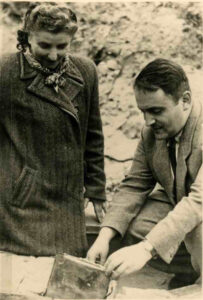Hersz Wasser (13.06.1910 – 1980)
The Secretary of the Ringelblum Archive, one of the three surviving members of the Oneg Shabbat group, activist of Poale Zion Left, Chairman of the Central Committee for Refugees.
Hersz Wasser, son of Lejb and Estera née Podlaska, was born on 13 June 1910 in Suwałki. In 1929, he graduated from the Laor Lyceum, and three years later from the Warsaw School of Economics, receiving a Master’s degree in economic sciences. After graduation, he moved to Łódź, where he worked as an accountant and got involved in political activism. As a member of Poale Zion-Left – the Jewish Social-Democratic Workers’ Party – he was in charge of the party library named after Ber Borochow. For five years he was secretary of the economics and statistics section of the Łódź branch of the YIVO Institute for Jewish Research. In December 1939 (before the establishment of the Łódź ghetto), Wasser married Bluma Kirszenfeld and moved with her to Warsaw, where, still in the milieu of left-wing Zionists, he became involved in Jewish social life.
Upon arriving in Warsaw, Wasser quickly made contact with Emanuel Ringelblum, who was starting his project to document the history of the Jews under the occupation. Over time, he joined Eliasz Gutkowski in acting as secretary of the Oneg Szabat group. His tasks included acquiring documents for the Archive’s collection, organising them and drawing up lists of the collected materials, and recruiting associates. Together with Ringelblum and Gutkowski, he also developed research plans, handouts and questionnaires. Wasser drew on his work at the Central Refugee Commission for the purposes of the Ringelblum Archive. He spent a considerable amount of time interviewing displaced persons, the notes from which were to form the basis for future studies on the annihilation of Jewish communities outside Warsaw.
Between December 1940 and July 1942, he kept a diary in which he described the reality around him. ‘[I] don’t want to write about myself – I am happy just to pass the day doing social work.’
In the spring of 1942, news began to reach the Warsaw Ghetto of the mass executions of Jews in Chelmno nad Nerem and the deportations from Lublin, which initiated Aktion‘Reinhardt’ (aiming to murder the Jewish population of the five districts of the General Government – Warsaw, Radom, Krakow, Lublin and Galicia). Hersz Wasser and Elijah Gutkowski then began to edit bulletins, which Wasser called ‘Oneg Shabbat press service bulletins’. Reports documenting the genocide were then sent to London.
In July 1942, the Warsaw Ghetto deportations began. In all probability, it was Hersz Wasser who transferred the materials of the Ringelblum Archive to a hiding place in the basement of the Borochow School at 68 Nowolipki St. Thus, he would have known where they were stored and could direct the excavation work after the war. Both Hersz and his wife, Bluma, managed to survive the deportations – together with other Oneg Shabbat members they found employment in the carpentry workshop of the Ostdeutsche Bautischlerei-Werkstätten GmbH, managed by Aleksander Lejb Landau, a fellow conspirator. In the spring of 1943, the Wassers made their way to the ‘Aryan’ side.
In April 1943, Wasser escaped from a transport to a labour camp in Trawniki and, under the name Henryk Wodnicki, hid with his wife in Warsaw. Even after leaving the ghetto, he continued to work on the Archive, documenting the Jewish experience under the occupation: he collected and copied the notes of other Jews in hiding (which he called ‘memory packagess’), created materials on how the workshops operated, and charted the course of the Warsaw Ghetto Uprising – some of his studies were sent to the London Delegation of the Polish Home Government.
The Wassers survived the Warsaw Uprising in a bunker on Suwalska Street, hiding with Pola Elster, Hersz Berlinski and Eliahu Erlich. In September 1944, the bunker was given away, and all but Hersz and Bluma were killed.
After the war, Wasser campaigned for the revival of Jewish social life. He was a member of the board of the Central Committee of Jews in Poland and head of the Warsaw branch of the Central Jewish Historical Commission. On behalf of Poale Zion-Left, he obtained a seat on the Warsaw National Council. He also continued his research: among other subjects, he investigated Poles hiding Jews and prepared expert reports for war criminal trials. Above all, however, he strove to bring out the Archive. When the first part was found on 18 September 1946, Wasser coordinated work on the identifying and verifying the documents. He was also arranging for his departure from Poland.

Hersz Wasser and Rachela Auerbach, photographed upon the discovery of part of the hidden Oneg Shabbat archive (GFH)
In 1946, he signed a contract with YIVO in New York, securing a position as a lecturer and researcher on the Holocaust of Polish Jews. In 1947, fearing for the further fate of the Ringelblum Archive, Wasser secretly sent more than 240 documents to YIVO, most of which were materials from the Archive, including Szlama Ber Winer’s account of the Chelmno-on-Ner death camp and the report Gehenna of Polish Jews under the Nazi occupation. The documents can be found there to this day, as part of the ‘Wasser Collection’.
Despite his efforts, Wasser did not succeed in immigrating to the United States. In 1950, along with his wife and daughter, he immigrated to Tel Aviv, where he became director of the Emanuel Ringelblum Institute for the Study of the Jewish Workers’ Movement he founded. He died in 1980.

